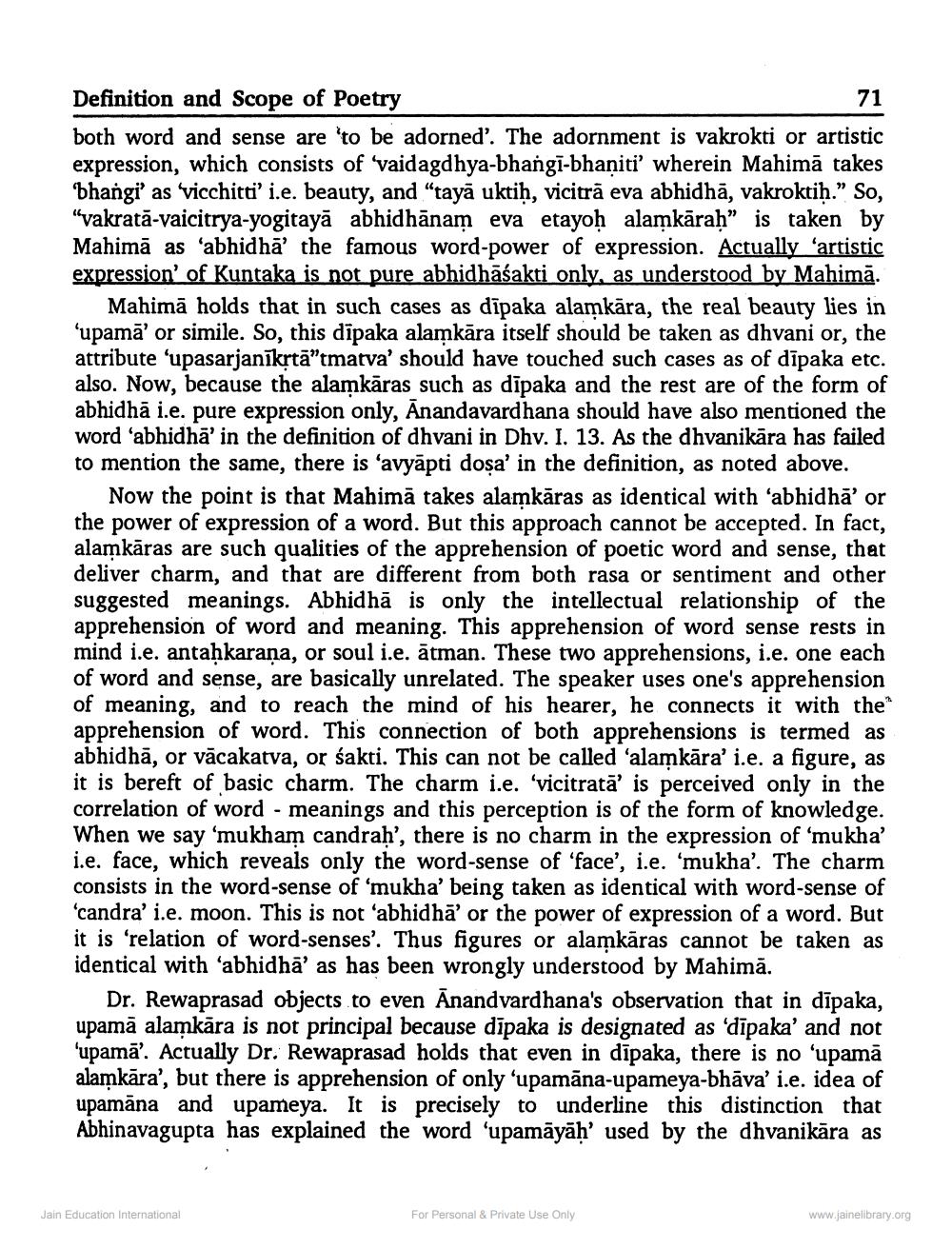________________
Definition and Scope of Poetry
71 both word and sense are to be adorned'. The adornment is vakrokti or artistic expression, which consists of 'vaidagdhya-bhangi-bhaniti' wherein Mahimā takes 'bhangi' as 'vicchitti' i.e. beauty, and “tayā uktih, vicitrā eva abhidhā, vakroktih.” So, "vakratā-vaicitrya-yogitayā abhidhānam eva etayoh alamkārah" is taken by Mahimā as "abhidhā' the famous word-power of expression. Actually 'artistic expression of Kuntaka is not pure abhidhāśakti only, as understood by Mahimā.
Mahimā holds that in such cases as dīpaka alamkāra, the real beauty lies in 'upamā' or simile. So, this dipaka alamkāra itself should be taken as dhvani or, the attribute 'upasarjanīkrtā”tmatva' should have touched such cases as of dīpaka etc. also. Now, because the alamkāras such as dīpaka and the rest are of the form of abhidhā i.e. pure expression only, Anandavardhana should have also mentioned the word 'abhidhā' in the definition of dhvani in Dhv. I. 13. As the dhvanikāra has failed to mention the same, there is 'avyāpti dosa' in the definition, as noted above.
Now the point is that Mahimā takes alamkāras as identical with Sabhidhā' or the power of expression of a word. But this approach cannot be accepted. In fact, alamkāras are such qualities of the apprehension of poetic word and sense, that deliver charm, and that are different from both rasa or sentiment and other suggested meanings. Abhidhā is only the intellectual relationship of the apprehension of word and meaning. This apprehension of word sense rests in mind i.e. antahkarana, or soul i.e. ātman. These two apprehensions, i.e. one each of word and sense, are basically unrelated. The speaker uses one's apprehension of meaning, and to reach the mind of his hearer, he connects it with the apprehension of word. This connection of both apprehensions is termed as abhidhā, or vācakatva, or śakti. This can not be called 'alamkāra' i.e. a figure, as it is bereft of basic charm. The charm i.e. 'vicitratā' is perceived only in the correlation of word - meanings and this perception is of the form of knowledge. When we say 'mukham candrah', there is no charm in the expression of 'mukha' i.e. face, which reveals only the word-sense of 'face', i.e. 'mukha'. The charm consists in the word-sense of 'mukha' being taken as identical with word-sense of 'candra' i.e. moon. This is not 'abhidhā' or the power of expression of a word. But it is 'relation of word-senses'. Thus figures or alamkāras cannot be taken as identical with 'abhidhā' as has been wrongly understood by Mahimā.
Dr. Rewaprasad objects to even Anandvardhana's observation that in dīpaka, upamā alamkāra is not principal because dīpaka is designated as 'dīpaka' and not ‘upamā'. Actually Dr. Rewaprasad holds that even in dīpaka, there is no 'upamā alamkāra', but there is apprehension of only ‘upamāna-upameya-bhāva' i.e. idea of upamāna and upameya. It is precisely to underline this distinction that Abhinavagupta has explained the word 'upamāyāh' used by the dhvanikara as
Jain Education International
For Personal & Private Use Only
www.jainelibrary.org




